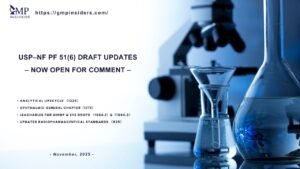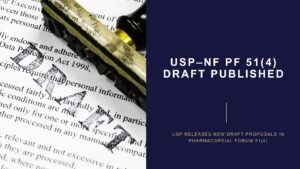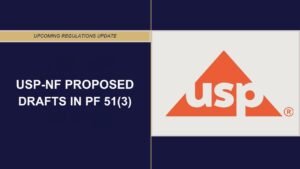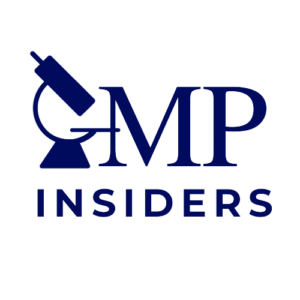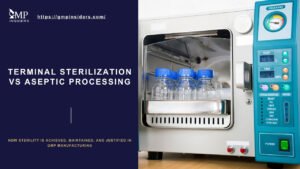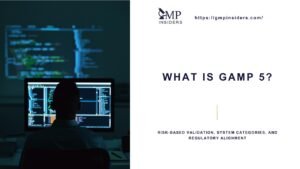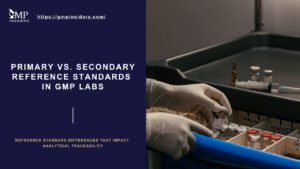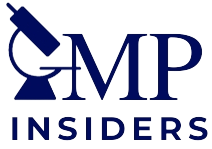GMP guidelines ensure that medicinal products are consistently produced and controlled according to quality standards. One such critical guideline is GMP Annex 1, which focuses on the manufacture of sterile medicinal products.
The interpretation of GMP Annex 1 plays a crucial role in ensuring the quality and safety of sterile medicinal products. Developed by the SwissMedicines Inspectorate, the technical interpretation guides key changes introduced in the revision of Annex 1 in 2022. We at GMP Insiders will explore the key points in this article.
Basics of GMP Annex 1
The revised GMP Annex 1 to the PIC/S GMP Guide (PE 009) was adopted on 9 September 2022 by the PIC/S Committee and came into force on 25 August 2023, with the exception of point 8.123, which will become binding from 25 August 2024.
GMP Annex 1 provides guidelines for the manufacture of sterile medicinal products, ensuring the prevention of contamination and ensuring the quality and safety of these products. It covers a wide range of topics, including premises, utilities, personnel training, production technologies, and quality control.
SwissMedicines Interpretation of GMP Annex 1: Q&A
The interpretation of GMP Annex 1 addresses several key areas related to the manufacture of sterile medicinal products. Here, we will explore the interpretation of different chapters of Annex 1.
Scope (Chapter 1)
The interpretation clarifies the application of Annex 1 to different types of products, such as Advanced Therapy Medicinal Products (ATMPs). It recognizes that ATMPs require specific considerations due to their nature and manufacturing technology.
For example, allogeneic and autologous cell therapy products, which cannot be terminally sterilized or sterile filtered, must be manufactured under conditions suitable to avoid microbial contamination.
Premises (Chapter 4)
The premises in which sterile medicinal products are manufactured play a crucial role in preventing contamination and ensuring product quality. Annex 1 provides specific requirements and guidelines for ensuring clean and controlled environments within these premises.
The interpretation emphasizes the importance of proper premises for the manufacture of sterile medicinal products. It highlights the requirement for separate airlocks for personnel and material in grade A and B cleanrooms.
Grade A and B Cleanrooms
![SwissMedicines Inspectorate: Interpretation of GMP Annex 1 [2022] | GMP Insiders Grade A and B Cleanrooms](https://gmpinsiders.com/wp-content/uploads/2023/11/Grade-A-and-B-Cleanrooms-1024x536.jpg)
Grade A and B cleanrooms are critical areas within the premises where the highest levels of cleanliness must be maintained. It is expected that new facilities have segregated airlocks for personnel and material, with unidirectional flows in these airlocks.
This means separate Material Airlocks (MALs) for transporting materials into and out of the cleanroom and separate Personnel Airlocks (PALs) for personnel entry and exit. Existing facilities that do not have segregated airlocks must ensure temporary separation of flows in the airlocks, supported by scientifically sound risk analysis and additional technical or organizational measures if necessary.
SEE MORE: Types of Airlocks Used in Pharmaceutical Industry
The transfer of materials, equipment, or components into and out of the cleanroom, including the critical zone within a grade A environment, represents a significant potential source and risk of contamination.
Therefore, careful consideration must be given to the technical and procedural measures associated with material transfer. In rare cases, materials can be brought into an isolator before sealing and decontaminated together with the isolator using a validated vaporized hydrogen peroxide (VHP) treatment.
However, in most cases, materials must be transferred to an isolator that has already been decontaminated. All materials must be sterilized before being moved through the physical barrier of the isolator to maintain their sterility and the integrity of the isolator.
SEE ALSO: RABS vs Isolators
Utilities (Annex 1, Chapter 6)
Utilities play a vital role in the manufacture of sterile medicinal products. The revised Annex 1 provides guidance on the requirements for water systems, including reverse osmosis (RO) systems and water for injection (WFI) distribution systems.
These systems must undergo regular sanitization and monitoring to ensure the quality and integrity of the water used in the manufacturing processes.
The requirements for RO systems include regular preventive sanitization or disinfection, regular change of membranes, and a suitable sampling schedule for microbial and bacterial endotoxin testing. WFI distribution systems require more stringent monitoring, with daily water sampling and periodic sampling of all points of use.
Process gas, such as air or nitrogen, is another critical utility in the manufacture of sterile medicinal products. Monitoring of process gas should occur as close as possible to the sterilization filter to ensure the efficiency of the gas sterilization process.
The interpretation recommends regular preventive sanitization and periodic change of membranes based on quality risk management principles and qualification data.
Personnel/Training (Annex 1, Chapter 7)
![SwissMedicines Inspectorate: Interpretation of GMP Annex 1 [2022] | GMP Insiders Personnel-and-Training](https://gmpinsiders.com/wp-content/uploads/2023/11/Personnel-and-Training-1-1024x536.png)
Personnel involved in the manufacturing of sterile medicinal products must undergo adequate training to ensure the highest level of aseptic behaviors and gowning practices. The revised Annex 1 emphasizes the importance of initial qualification and regular requalification of employees working in grade A and B areas or involved in aseptic processes.
Training programs should cover both theoretical knowledge and practical aspects of aseptic processes. Regular assessments, including visual and personnel monitoring examinations, should be conducted to confirm compliance with gowning procedures and aseptic behaviors.
Employees should also participate in successful aseptic process simulations (APS) at least annually to reinforce their understanding and skills.
Production and Specific Technologies (Annex 1, Chapter 8)
The production of sterile medicinal products requires specific technologies to ensure sterility and product quality. The revised Annex 1 provides guidance on various aspects, including closed systems, aseptic connectors, and tubing welding.
Closed systems are widely used in the manufacture of sterile medicinal products to prevent contamination. The Annex 1 interpretation emphasizes the need to minimize the risk of contamination when opening or piercing closed systems.
Measures such as opening the system in a decontaminated isolator or a laminar airflow cabinet can be taken to maintain the sterility of the system.
Aseptic connectors are commonly used to connect sterile equipment in the manufacturing process. The acceptance of sterile aseptic connectors purchased from qualified suppliers is permitted, provided that the supplier’s qualifications and validation data are thoroughly assessed.
The use of tubing welding for aseptic connections is generally discouraged due to the difficulty in monitoring and the risk of integrity deficiencies.
Initial Autoclave Validation and Re-validation
![SwissMedicines Inspectorate: Interpretation of GMP Annex 1 [2022] | GMP Insiders Annex 1 - Initial Autoclave Validation and Re-validation](https://gmpinsiders.com/wp-content/uploads/2023/11/Initial-Autoclave-Validation-and-Re-validation-1.jpg)
Sterilization is a fundamental component of pharmaceutical manufacturing, and Annex 1 outlines the requirements for autoclave validations. Initially, each loading pattern must undergo validation to ensure sterility.
Additionally, re-validation of each loading pattern should occur annually. The key here is to establish and maintain the sterility of the process by validating each loading pattern. This practice not only ensures the quality of the products but also safeguards patient safety.
Routine Re-validation for Moist Heat Sterilization
Moist heat sterilization is a common method used in pharmaceutical manufacturing. Annex 1 addresses the need for routine re-validation in such processes. To ensure that the positions used for temperature monitoring during sterilization are accurate, routine re-validation should include tests.
This helps maintain the integrity of the sterilization process, ultimately preserving product quality and patient safety.
Opening Closed Systems and Aseptic Connections
The annex discusses the challenges of opening closed systems during the manufacturing process. Opening sterile, closed systems should be avoided whenever possible. When necessary, these systems should be returned to a sterile state through validated sterilization processes.
The document also highlights the possibility of using laminar airflow (LAF) for opening, although this should be reserved for exceptional cases, as it poses a higher risk of contamination from the environment.
Integrity of Single-Use Systems (SUS)
Single-use systems play a significant role in pharmaceutical manufacturing. Annex 1 emphasizes the importance of integrity testing for critical SUS. This testing should be conducted by the end-user on-site before use in production. In cases where deep visual inspection is challenging, temporary measures may be implemented to minimize the risk of contamination.
SEE ALSO: Contamination, Cross-Contamination and Mix-Ups
Acceptance Criteria for SUS
The acceptance criteria for single-use systems should consider various factors, including the intended use, quality aspects, functionality, and validation/qualification requirements. Defining these criteria in a written specification is essential, ensuring that they align with the specific application and potential interactions with the product.
Extractable and Leachable Studies
Annex 1 offers guidance on the use of extractable and leachable data provided by suppliers. End-users are encouraged to evaluate this data and consider a comprehensive risk assessment when deciding whether to conduct leachable studies. The decision should consider factors such as the route of administration and dosing frequency.
Environmental & Process Monitoring (Annex 1, Chapter 9)
![SwissMedicines Inspectorate: Interpretation of GMP Annex 1 [2022] | GMP Insiders Annex 1 - Environmental and Process Monitoring](https://gmpinsiders.com/wp-content/uploads/2023/11/Single-Use-Systems-SUS-1.jpg)
Environmental monitoring and quality control are crucial aspects of ensuring the sterility and quality of medicinal products. The revised Annex 1 provides guidance on the sampling requirements for ongoing monitoring of water for injection (WFI) and the monitoring of process gas.
Regular sampling of WFI at various points of use is necessary to characterize the quality of the water. The frequency of sampling should be determined based on risk assessments and routine monitoring data, taking into consideration the maintenance of a validated state.
Monitoring process gas, such as air or nitrogen, close to the sterilization filter is essential to ensure the efficiency of the gas sterilization process. The air velocity in unidirectional airflow systems must be defined to maintain unidirectional and uniform airflow conditions at critical working positions.
RELATED: Airflow Visualization Smoke Studies (AVS) in Cleanrooms
Regular Review of Risk Assessments (9.4)
Annex 1 recommends the regular review of risk assessments. However, the frequency of these reviews depends on the level of risk. The more risks identified, the more frequent the reviews should be.
This might also depend on the extent of risk control measures applied and the level of uncertainty present in earlier risk assessments. Regular environmental monitoring trend reports, typically prepared annually, may trigger the need for risk assessment reviews.
Statistics for Alert Level Establishment (9.10)
Determining alert levels for environmental monitoring requires careful consideration. For new processes with limited data and experience, it’s acceptable to calculate alert level limits as a percentage of the action level limit.
As more data becomes available, statistical methods from the environmental monitoring data should be used. These methods may include nonparametric approaches, tolerance limits, or cut-off values.
Replacing Microbiological Monitoring (9.22 & 9.23)
The question arises whether traditional microbiological monitoring, such as settle plates and air sampling, can be replaced by newer integrated sampling and testing systems, like Rapid Microbiological Methods (RMM).
While Annex 1 allows for the use of such advanced methods, equivalence must be demonstrated. Validation data, including recovery studies, is essential. A full understanding of triggers and limits for these new methods is required.
Bracketing and Matrix Approaches (9.36ii)
Bracketing or matrix approaches may be applied when equivalence can be demonstrated between different materials, such as glassware and stoppers. This approach simplifies the monitoring of different materials with proven similarity.
Differentiating Contaminations (9.46)
Unlike ISO 13408-1, GMP Annex 1 does not differentiate between contaminations based on CFU counts. Any contaminated unit with a contamination level exceeding zero CFU results in a failed Aseptic Process Simulation (APS), necessitating actions according to Chapter 9.46.
Quality Control (QC) (Annex 1, Chapter 10)
![SwissMedicines Inspectorate: Interpretation of GMP Annex 1 [2022] | GMP Insiders Annex 1 - Quality Control](https://gmpinsiders.com/wp-content/uploads/2023/11/Quality-Control-QC.jpg)
The interpretation highlights the requirements for quality control in the manufacture of sterile medicinal products. It addresses the expectations for sampling plans for regular ongoing monitoring of WFI and the use of single-use systems.
The interpretation also discusses the acceptability of introducing small amounts of product or cells into a sterile closed system and the use of sterile aseptic connectors purchased from qualified suppliers.
Specification Limits for Raw Materials and Components
Determining specification limits for raw materials and components is a crucial step in ensuring the quality and sterility of sterile medicinal products. These limits should take into account the nature of the raw materials, their origin, and whether they can promote microbial growth.
It’s essential to consider relevant chapters and monographs in the Pharmacopeia, marketing authorization requirements, and other regulations. Additionally, justifying the specifications is of paramount importance.
Bioburden Testing for Raw Materials
GMP Annex 1 mandates that bioburden testing be conducted on each batch of raw material during incoming control. Furthermore, it should be tested on the compounding solution in which the material is formulated before sterile filtration. This double-check ensures that raw materials do not introduce contaminants that could compromise the sterility of the final product.
Understanding “Different Lyophilization Loads”
The document refers to “different lyophilization loads,” which can be a source of confusion. This term means that each lyophilizer used for each batch should undergo testing. If multiple lyophilizers are used, samples from each should be tested.
Similarly, if different batches are processed in the same lyophilizer, each should be assessed. This approach aims to cover all potential variations and ensure the sterility of the lyophilized product.
Changes to the Previous Version
The revised Annex 1 introduces significant changes and clarifications compared to the previous version. Manufacturers of sterile medicinal products must be aware of these changes and ensure compliance with the new requirements.
Changes include the introduction of specific considerations for ATMPs, the requirement for separate airlocks in grade A and B cleanrooms, and the need for regular requalification and APS participation of personnel involved in aseptic processes.
The revised Annex 1 also emphasizes the importance of integrity testing for single-use systems and the qualification of suppliers.
Conclusion
The interpretation of GMP Annex 1 provides valuable guidance for manufacturers of sterile medicinal products. It covers various aspects, including premises, utilities, personnel training, production technologies, environmental monitoring, and quality control.
By following the interpretation, manufacturers can ensure compliance with cGMP and maintain the sterility and quality of their products. It is essential for manufacturers to stay updated with the interpretation to meet regulatory requirements and ensure the safety and efficacy of their sterile medicinal products.



